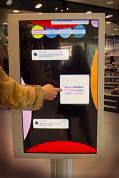Starting this fall, The INC Urban Screens researchers Matthijs ten Berge, Denisse Iglesias and Sabine Niederer will participate in the research project SpaceSee, initiated by Mettina Veenstra at CREATE IT Applied Research at the HvA.
Screens and projections of various shapes and sizes are increasingly present in public and semi-public space worldwide. Shops and malls, hospitals, libraries, and outdoor open spaces such as public squares or public transport stations are examples of places where we can find these visual display systems. They are addressed with different names: urban screens, public screens, narrowcasting, digital-out-of-home, digital signage, digital outdoor, public displays, outdoor media, and electronic billboards.
 Viewers often perceive them as instruments of digital advertising rather than information channels, but these screens can do a lot more than mere commercial messaging. While it is true that screens in public space are mainly used for advertising purposes, the scope of possibilities is not limited to them. Social interaction, and enhancing the safety and quality of public space itself are among the explored alternative uses.
Viewers often perceive them as instruments of digital advertising rather than information channels, but these screens can do a lot more than mere commercial messaging. While it is true that screens in public space are mainly used for advertising purposes, the scope of possibilities is not limited to them. Social interaction, and enhancing the safety and quality of public space itself are among the explored alternative uses.
Outdoor media companies in the Netherlands often meet resistance against public screens from both local governments and citizens. However, foreign initiatives (eg. the Big Screens in the UK, bought by the city councils and run by the BBC) show that public screens can contribute to the quality and positive perception of public space. Identifying this as an area of research and innovation in the dutch context, SpaceSee intends to make outdoor media add value to public space and wants to find out how public screens can support the needs and activities of people and organisations in public space. It will aim at collaboration and organisation structure on a local and regional level and will investigate exploitation models for screens which do not merely work from a marketing perspective.
SpaceSee has two types of participants, consortium partners that includes applied research centers, outdoor media, traditional media and architecture bureaus, and a group of external partners, consisting of individuals, organizations and companies, who will be invited to exchange knowledge, expertise, and questions. Consortium and external participants cover a wide range of disciplines at work in the field of urban screens: content creation, architecture, urban design, management, safety of public space, hardware, software, education/science, culture/art, marketing, interactivity technology, games, innovation and tourism.
The timeline for the project will be 2 years starting September 2011, after which a publication will be released with guidelines for urban screens.


